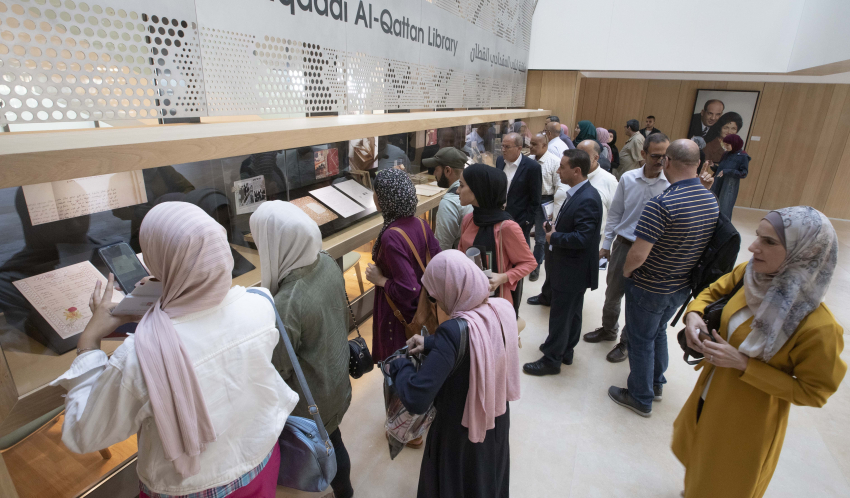
Ramallah – (A.M. Qattan Foundation):
The A.M Qattan Foundation organised a symposium entitled “Books in Captivity”, presented by ex-prisoners Abdullah Abu Ghdeib and Khalil Ashour at the Leila-Miqdadi Al-Qattan Library. The symposium launched the art installation “A Needle in the Binding” by Italian artist Beatrice Catanzaro which explores the prisoners’ book section at the Nablus Municipality Library.
“Books are a manifestation of the cultural life of prisoners. The role of books has been essential in the struggle.” With these words, Fida Touma, Director General of the A.M. Qattan Foundation, opened the symposium. “Therefore, we determined to have the books in captivity project as the first art project at the Leila Miqdadi Al-Qattan Library, because the prisoner’s cause is at the heart of our national struggle.” Touma added.
During the symposium, Abu Ghdeib noted that “Each book is a readable version of the author’s mind. It adds the knowledge of the author to the knowledge of the reader, in addition to transferring the prisoner from within the walls surrounding and detaching him from life, into the lives of the protagonists the of the book, so he feels himself part of another life.” Imprisonment then remains an imprisonment of the body not the soul and the mind. According to Abu Ghdeib, the knowledge that is acquired by reading refines the soul and improves behaviour, it also creates uniformity in revolutionary thought. Consequently, books and novels were difficult to find inside prisons, because the Israeli authority prevents Palestinian prisoners and detainees from obtaining them.
Regarding the construction of the prison’s library, Ashour said: “We used all means to establish a small library in prison, which initially contained 80 books in 1972. Within ten years, we were able to reach 1800 books which later formed the prisoners’ section at the Nablus Municipality Library.”
“We started with restoring the books we had by using “plaster” and glue smuggled from prisoners to bind torn books, in addition to threading them with needles and the threads of canvas bags. We smuggled in new books through removing the covers and replacing them with photos of actresses and singers.” Ashour added.
“Not only were books used to gain knowledge, they were also used as a confrontation tool. Prisoners used books to smuggle letters between prisoners in different prisons. Letters were hidden between the cover of the book and a piece of cardboard covered to look like a book cover. Books were also used to smuggle in needles, razor blades, political and organizational statements from outside the prison and between prison sections.” Ashour explained.
Qadri Abu Baker, Chairman of the Detainees and Ex-Detainees Commission talked about his experience in captivity in ‘Asqalan Prison. Books were unattainable; however, prisoners were able to establish a weekly magazine inside the prison by writing articles on food wrappers after washing and drying them. The magazine was later turned into a monthly magazine.
Ex-prisoner Aisha Odeh said that books were not an option to be negotiated or allowed, they were means of pressuring and punishing female prisoners. Salah Khawaja, also an ex-prisoner spoke about the prisoners’ ability to transfer letters from al-Naqab prison during the First Intifada in 1978 on transparent paper, which were placed inside small capsules and transferred to the families of prisoners during visits.
The installation borrows a collection of books from the prisoners’ section at the Nablus Municipality Library and displays them in new spaces to provoke discussions around books in captivity.
The artwork has been installed in three different locations in Palestine; the Khalidi Library in Jerusalem as part of the Jerusalem Show organized bel Al-Ma’mal Foundation for Contemporary Art; the Birzeit University Museum as part of the Cities Exhibition – Between Ebal and Gerzim; and now at the Leila Miqdadi Al-Qattan Library.
